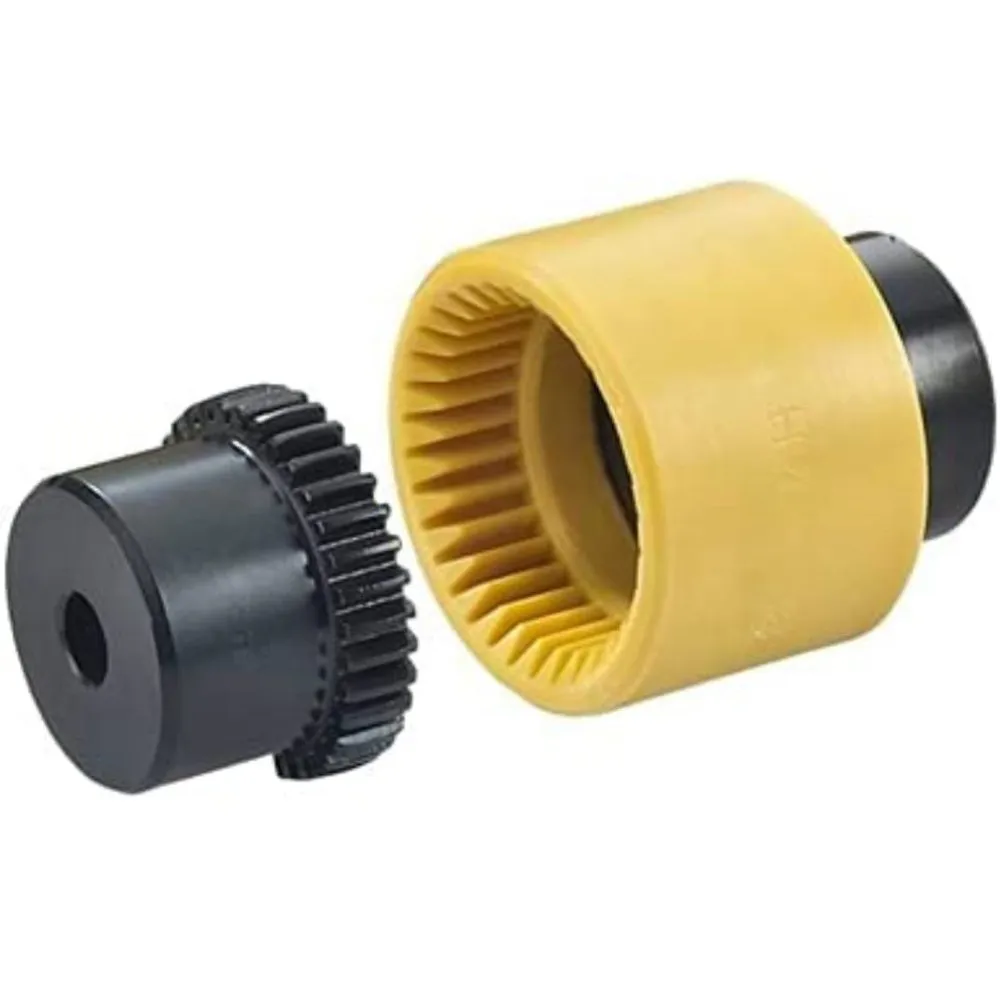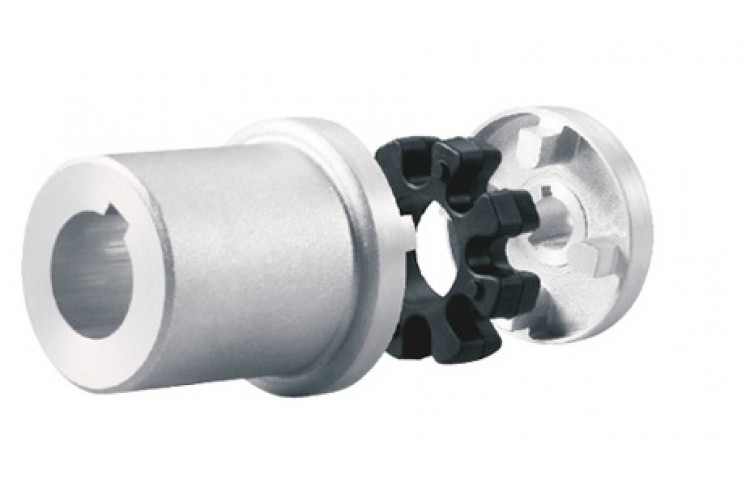Product Description
SG7-8 Generator Drive Disc Spring Coupling With High Torque Capacity
Product Description
| Features: | |
| 1. Excellent response and high torque capacity | |
| 2. Zero backlash | |
| 3.Identical clockwise and anticlockwise rotational characteristics | |
| 4.Stainless steel plate springs absorb parallel,angular misalignment and shaft end-play | |
| 5.Clamp type |
|
| Material: | Aluminum Alloy |
| Finish: | Anodizing Silver |
| Application: | Used for transmitting power in kinds of mechanical equipments such as blower fan, pump, chemical industry, petroleum, metallurgy |
| Remark | |
| 1.The moment of inertia and the quality is calculated according to the maximum shaft hole. | |
| 2.Bore dimensions can be customized | |
Product Picture
Drawing:

Explaining the Concept of Backlash and How It Affects Drive Coupling Performance
Backlash is a mechanical phenomenon that refers to the amount of free movement or play between the mating components of a drive system. In the context of drive couplings, backlash is the angular or linear displacement that occurs when there is a change in direction or a reversal of motion. It is mainly a result of clearances between the coupling’s mating elements.
The presence of backlash can have both positive and negative effects on drive coupling performance:
- Negative Effects of Backlash:
- Reduced Accuracy: Backlash can introduce inaccuracies in position control systems, especially in applications requiring precise positioning. The free movement between the coupling elements can result in a delay in response when the direction of rotation changes, leading to positioning errors.
- Vibration and Noise: Backlash can cause vibration and noise during operation, especially in systems with frequent changes in direction or load. The impact and collision of the mating elements can generate noise and contribute to mechanical wear.
- Increased Wear: In systems with significant backlash, the constant impact between the mating components can accelerate wear and reduce the lifespan of the coupling and other connected machinery.
- Positive Effects of Backlash:
- Shock Absorption: In certain applications, a controlled amount of backlash can act as a shock absorber, dampening sudden impact loads and reducing stress on the system during abrupt changes in motion.
- Misalignment Compensation: Backlash can compensate for minor misalignments between shafts, reducing the risk of damage and excessive load on the coupling and connected components.
- Thermal Expansion Compensation: Backlash can help accommodate thermal expansion and contraction of the components, allowing the coupling to function effectively even as the temperature changes.
The appropriate amount of backlash depends on the specific application and the coupling type. In some cases, minimizing backlash is essential for precision and accuracy, while in others, a controlled amount of backlash can be beneficial for shock absorption and misalignment compensation.
It’s crucial to consider the effects of backlash when selecting a drive coupling and designing a power transmission system. Manufacturers often provide information on the level of backlash in their coupling designs, enabling users to make informed decisions based on their application’s requirements.

How to Select the Right Drive Coupling for Specific Torque and Speed Requirements
Choosing the appropriate drive coupling for specific torque and speed requirements is essential to ensure reliable and efficient power transmission in mechanical systems. Here are the steps to help you make the right selection:
- Identify Torque and Speed Parameters: Determine the maximum and minimum torque values that the coupling will experience during operation. Also, establish the required operating speed range.
- Consider the Application: Evaluate the application’s characteristics, such as the nature of the driven equipment, the presence of shock loads, vibrations, and misalignments. Different applications may require different coupling types and designs.
- Calculate Service Factor: Apply a service factor to the calculated torque to account for any variations in the load during operation. The service factor typically ranges from 1.2 to 2, depending on the application’s demands.
- Choose the Coupling Type: Based on the torque, speed, and application requirements, select the appropriate coupling type. Common coupling types include elastomeric couplings, grid couplings, gear couplings, and metallic disc couplings.
- Torsional Stiffness and Damping: Consider the desired level of torsional stiffness and damping based on the application’s need for rigidity and vibration absorption. High-speed applications may require couplings with good damping characteristics to prevent resonance.
- Temperature and Environment: Take into account the operating temperature and environmental conditions. Extreme temperatures or corrosive environments may require specific coupling materials or coatings.
- Alignment and Misalignment Tolerance: Assess the alignment capabilities of the coupling. Flexible couplings can accommodate misalignments, while rigid couplings require precise alignment.
- Space Limitations: Consider any spatial constraints for coupling installation. Some couplings may have compact designs suitable for confined spaces.
- Budget and Maintenance: Factor in the initial cost and ongoing maintenance requirements of the coupling. While some couplings may have higher upfront costs, they might offer longer service life and lower maintenance expenses.
- Consult with Manufacturers: Reach out to coupling manufacturers or specialists to discuss your specific requirements. They can provide expert advice and recommend suitable couplings for your application.
By carefully evaluating torque and speed requirements, considering the application’s characteristics, and selecting a coupling that matches the demands of the system, you can ensure optimal performance and longevity of the power transmission setup.

Can a Damaged Drive Coupling Lead to Transmission Issues in Vehicles?
Yes, a damaged drive coupling can lead to transmission issues in vehicles. Drive couplings are critical components that connect the engine to the transmission and other drivetrain components, allowing the transfer of power and torque. When a drive coupling is damaged or worn, it can negatively affect the performance and reliability of the entire transmission system. Here are some ways in which a damaged drive coupling can lead to transmission issues:
- Power Loss: A damaged drive coupling may not efficiently transfer power from the engine to the transmission. This can result in a loss of power, leading to reduced acceleration and overall vehicle performance.
- Transmission Slippage: When a drive coupling is damaged, it may not provide a secure connection between the engine and the transmission. This can lead to transmission slippage, where the transmission fails to engage properly, causing the vehicle to hesitate or slip out of gear while driving.
- Increased Transmission Wear: A damaged drive coupling can cause vibrations and misalignments in the drivetrain, leading to increased wear on the transmission components. Excessive wear can result in premature failure of transmission gears, bearings, and other critical parts.
- Difficulty in Shifting Gears: A faulty drive coupling may result in difficulty shifting gears, making it hard for the driver to smoothly transition between different gears. This can lead to jerky gear shifts and impact the vehicle’s overall drivability.
- Strange Noises: A damaged drive coupling may produce unusual noises, such as clunking, rattling, or grinding sounds, indicating a problem in the drivetrain. These noises can be a warning sign of potential transmission issues.
- Overheating Transmission: If a drive coupling is not functioning correctly, it may cause the transmission to work harder to compensate for the power loss. This increased workload can lead to overheating of the transmission fluid, potentially causing damage to internal components.
- Transmission Fluid Leaks: In some cases, a damaged drive coupling can cause leaks in the transmission system. Transmission fluid leaks can result in a loss of fluid, leading to decreased lubrication and potential damage to the transmission.
- Poor Fuel Efficiency: A malfunctioning drive coupling can contribute to poor fuel efficiency since the engine may not efficiently transfer power to the transmission and wheels, leading to increased fuel consumption.
It is essential to regularly inspect and maintain the drive coupling and other transmission components to prevent potential issues. If any signs of damage or wear are noticed, it is crucial to address the problem promptly and replace the damaged drive coupling to avoid further transmission problems and ensure the vehicle’s safe and smooth operation.


editor by CX 2023-08-31
